Claudio Ligresti1*, Fabrizio Malan2, Alberico Motolese3, Marcello Del Zotti4
1Professor, Director of Plastic Surgery Maria Pia Hospital Turin, S. Rita Hospital Vercelli, Italy
2Professor, Director of Plastic Surgery Hospital CTO Turin, Italy
3Director of Dermatology Hospital Reggio Emilia, Italy
4Plastic Surgery General Hospital Bari (Dr. M. Del Zotti), Italy
*Correspondence author: Claudio Ligresti, Professor, Director of Plastic Surgery Maria Pia Hospital Turin, S. Rita Hospital Vercelli, Italy; Email: [email protected]
Published On: 30-04-2024
Copyright© 2024 by Ligresti C, et al. All rights reserved. This is an open access article distributed under the terms of the Creative Commons Attribution License, which permits unrestricted use, distribution and reproduction in any medium, provided the original author and source are credited.
Abstract
The fact that chronic and complex wounds are a serious problem, both for those affected and for the health care system, has been known for decades. Most chronic wounds can be healed through targeted treatment of the cause of the wound and optimal wound care. This includes not only phase-adapted modern wound care, but also, in particular, preparation for surgical coverage. The correct preparation of the wound bed, also known as conditioning, plays an important role in this.
In recent years, the use of Cold Atmospheric Plasma (CAP) has emerged as a promising new option. Here, the wound is regularly treated with a partially ionized gas. According to studies, this active gas mixture has antimicrobial properties and promotes wound healing by activating cell regenerative processes.
To test the efficacy of cold plasma therapy, for complex hard to heel wound with difficult conditions, 40 patients with 41 wounds were included in a retrospective, multicenter observational trial in Italy.
The wounds were complex wounds of different genesis that had been present for at least 2 months (> 60 days) were treated with cold atmospheric plasma, generated with the CE approved handheld plasma device plasma care®. The treatment, as an add on to standard wound therapy, was performed once a week and for 1 Minute per treated wound area for an intervention period of 4 weeks.
In the intervention period, a total of 41 wounds from 40 patients were treated and measured. Two patients left the trial, the others showed an average wound size reduction of 28% within 30 days. Of all wounds, two were completely closed at the end and 10 wounds even achieved a reduction of at least 40%. Analyzed by initial wound size, 43% of wounds smaller than 18 cm² reduction of 40 %. No improvement or worsening of the wound size was only observed in five wounds. The observational trial showed a reduction in the bacterial load and accelerated wound healing. In addition to the bacterial load, improved wound bed conditioning was also demonstrated. Cold plasma therapy is well suited for locally targeted application to promote wound healing. It is an uncomplicated and quickly applicable method with no known side effects or risks at present.
Keywords: Cold Atmospheric Plasma; Chronic Wounds; Hard to Heal Wounds; Complex Wounds; Infected Wounds; Critical Colonization; Wound Bed Preparation; Wound Conditioning
Introduction
Chronic Wounds
The treatment of patients with chronic wounds is becoming increasingly complex. In combination with the necessary treatments such as wound cleansing, debridement and exudate management, the antimicrobial regime is absolutely important. But also highly developed treatments such as skin replacement procedures, as well as surgical coverage, play a decisive role alongside modern wound care. Physiological wound healing is a temporally and regionally controlled complex process with the primary goal of restoring tissue integrity and function. Here, the microbiome of the wound plays a predominant role. Critical colonization or even local infection further complicates wound healing.
Recent advances in molecular science have given us a better understanding of wound healing and have opened up new technical possibilities in wound treatment. Modern therapies, such as the use of cold atmospheric plasma, can significantly reduce the time needed to prepare for surgical coverage, which is expensive in terms of health economics. Likewise, the progressing number of multi resistant germs and the weakness of antibiotic treatment the development of alternative wound cleaning like low-temperature atmospheric plasmas became more and more important.
One of the first clinical trials on wound treatment with low-temperature atmospheric plasmas, which were conducted by the Max-Planck Institute for Extraterrestrial Physics in Germany in the early 2010s, showed the effectiveness of treating and cleaning skin and wounds without thermal injuring. The first application of CAP for wound disinfection was proposed. To show the benefit of CAP for the treatment and wound bed preparation of complex hard to heal wounds an observational trial was started to demonstrate the efficacy of CAP reducing the bacterial load in complex chronic wounds.
Cold Atmospheric Plasma
Plasma is an ionized gas, which is the fourth aggregate state after solid, liquid and gas. While naturally occurring plasma, such as that found in the sun, is very hot, artificially generated, so-called Cold Atmospheric Plasmas (CAP for short) have temperatures in the range of room temperature and can be used on patients. It is a promising new treatment option for wounds, especially chronic wounds, as it has been shown to improve wound healing [1-5]. There is evidence that this effect occurs, among other things, through the reduction of pH as a strongly alkaline pH has been associated with chronic wounds [4-7].
Material and Methods
Design
The aim of the observational trial was to show the efficacy of CAP and plasma care for antimicrobial treatment and wound bed preparation of wounds older than 2 months. Evidence was obtained by swabbing the bacterial load at day 0, after 15 days and at the end (after 30 days) Recruitment of 10 patients per selected clinical center, 40 patients in total. Plasma care® was applied once a week. Dressing changes were made two to three times per week, as documented in the patent file with an active agent-free dressing.
Recruitment Centers
- Asti – S.Anna Clinic (Prof.C. Ligresti) – Coordination Center
- Dermatology Hospital Reggio Emilia (Dr. A. Motolese)
- Plastic Surgery General Hospital Bari (Dr. M. Del Zotti)
- Turin – Plastic Surgery CTO (Prof. F. Malàn)
The centers sent the following data to the coordinating center:
Declaration of consent: This Declaration consists of two parts, namely the consent to the (clinical) trial itself and consent to the processing of personal data. Patient recruitment data sheets, clinical history of the lesion and results of swabs taken during the month of treatment, and adverse effects.
Patients, Inclusion and Exclusion Criteria
40 Patients between the ages 16 and 94 (average of 69) were included in the trial. Patient 22 had two wounds, all other patients one wound. The wound size was on average 22,65 cm² with a standard deviation of 14,71 with wounds between 2 cm² and 64,1 cm² at the beginning of the CAP treatment.
Inclusion Criteria
- Wound or skin ulcer with known etiology for more than 60 days
- Ulcer or semi-ulcerated wound
- Various pathogenesis
Exclusion Criteria
- Wounds development < 60 days
- Neoplastic ulcers
- Patients treated with antibiotics
- Patients treated with negative pressure
Treatment Protocol
- The maximum duration of the observation period is 30 days
- Assessment of infection with smear (level 0 (1 visit) level 15 (after 15 days) level 30 (after 30 days)
- Frequency of CAP was once a week, for 1 Minute per area
- Frequency of dressing change is 1 time every 2-3 days (2 per week)
- If necessary, debridement (surgical or mechanical) of the lesion is performed beforehand
- Dressing includes washing the wound with saline, applying a dressing with Alginate or Hydro fiber without silver or other antimicrobials, covered with polyurethane, in case of hyper-exudation
- Dressings can be applied either at home, in public and/or private clinics, or as inpatient treatment. The person in charge of each center must ensure that there is no disruption during the observation period
Analysis and Outcome Measurements
Objective: The correct preparation of the wound bed, also known as conditioning for wounds older than 2 months by swabbing the bacterial load at the initial stage (zero), intermediate stage (after 15 days) and final stage (after 30 days).
Possible Outcome:
- Cure
- Clinical improvement
- Consistent result
- Occurrence of increased infections
Assessment Parameters and Evaluation:
- Age, sex and comorbidities (max. 5 diseases) of the patient.
- Ethology of the lesion: Diabetes – venous insufficiency – arteriopathy – Decubitus – Traumatic wound
- Area of the lesion: Evaluation by measurement of the area and photography
- Hyperemia and/or peri-lesion skin maceration
- Pain assessment by VAS (Visual Analog Scale)
- Characteristics of the bottom of the lesion Cleaned – Fibrinous – Devitalized – Exudative
- Reduction and/or differentiation of bacterial load by buffering
Measurement of Wound Size
The wound size was automatically recorded with the “imito” wound app developed by the Imito AG. The imito app is a noncontact digital planimetry application tool for digital wound measurement. A file can be created for each patient, in which the images of the wound are automatically saved chronologically and the wound sizes are determined by the app’s algorithms. Therefore, a QR code must be positioned at the same level as the wound (Fig. 1). This approach avoids underestimation or overestimation of the wound area. The photographs must be taken directly of the wound, avoiding axis deviation. The app can be used on Android and iOS cell phones. The app is an evaluated, GDPR-compliant application for data processing and is certified as a medical device. The license for this was acquired by the hospitals.
In addition to the effect on wound healing, the reduction of bacteria, fungi and viruses is also an important effect of cold plasma [8-12]. Particularly in infected wounds, the synergistic effect of bacterial reduction – including antibiotic-resistant bacteria and stimulation of wound healing may represent the decisive advantage of this treatment method [10,13-15].
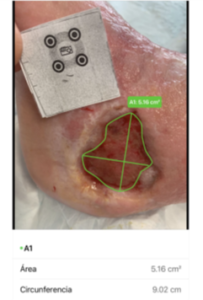
Figure 1: Measurement of wound size.
Scores
Documentation of the wound findings is an important parameter for objectifying wound development and the healing process. In addition to photo documentation (area) by imito wound app, a verbal description of the wound findings completed the documentation.
Wound bed:
- Tissue granulation = 1
- Tissue fibrinous = 2
- Tissue necrotic = 3
Wound bed:
- Tissue granulation = 1
- Tissue fibrinous = 2
- Tissue necrotic = 3
Swab results:
- Negative swab = 0
- Positive swab; 1 bacterium = 1
- Positive swab; more than 1 bacteria = 2
VAS Pain Score
The visual analog scale (VAS, Fig. 2) is a validated, subjective measure for acute and chronic pain. Scores are recorded by making a handwritten mark on a 10 cm line that represents a continuum between “no pain” and “worst pain.”
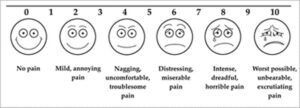
Figure 2: VAS Score, figure from Ghaderi, et al., [16].
Results
Overall Analysis
40 wounds with a wide range of wound sizes, a maximum wound size of 64.1 cm² and a mean wound size of 22.6 cm² (standard error 14.71, Table 1) were treated with cold plasma for 30 days. During this time, the wound size was reduced by an average of 28% compared to day 0. It is noteworthy that within this group the wound size of large wounds (over 18 cm², 21 of the 40 patients mentioned above) was reduced by an average of 31%. Wounds with an initial size smaller than 18 cm² achieved in 43% a reduction of 40% of the wound size.
Wound Size in cm² | Wound Size reduction in % | Pain (VAS score) | ||||||||
All Wounds | Wounds > 18 cm² | All Wounds | Wounds > 18 cm² | All Wounds | Wounds > 18 cm² | |||||
Day | Average | SD | Average | SD | Average | Average | Average | SD | Average | SD |
0 | 22,7 | 14,7 | 34,3 | 10,6 | 0% | 0% | 5,6 | 2,6 | 5,5 | 2,5 |
15 | 20,7 | 13,6 | 30,2 | 10,8 | 10% | 12% | 5,2 | 2,4 | 4,9 | 1,9 |
30 | 16,5 | 11,1 | 23,7 | 9,4 | 28% | 31% | 4,6 | 2,2 | 4,4 | 1,9 |
Table 1: Wound size, Reduction of wound size compared to day 0 and development of pain within 30 days of plasma treatment.
In 60% of the 40 wounds treated, the exudate improved over the course of treatment, in 35% it remained the same and in 5% it worsened. Pain improved in 50%, remained unchanged in 38% and worsened in 8%. However, the worsening of the wounds cannot necessarily be linked to the CAP due to the complexity and the underlying disease of this patients. Wound area was reduced in 85% of wounds during the observation period, remained the same in 5% and increased in 13%. The swab revealed an improvement in 55%, no change in 30% and a worsening of the situation in 15% (Table 2).
Wound Bed | Exudate | Pain | Area | Swab | |
Deterioration | 10% | 5% | 13% | 8% | 15% |
Constant | 25% | 35% | 38% | 5% | 30% |
Improvement | 65% | 60% | 50% | 85% | 55% |
Table 2: Overview over success of treatment.
First Case report
Male patient with diagnosed senile dementia, bedridden developed a sacral decubital ulcer of 25.6 square centimeters in diameter (Fig. 3,4). The following parameters were recorded at the baseline visit (day 0), day 15 and day 30.
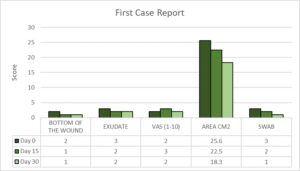
Figure 3: First case report, parameters recorded at the baseline visit.
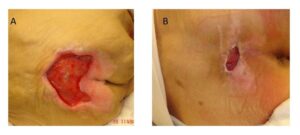
Figure 4: First case report, A) after 15 days and B) after 30 days and 5 CAP treatments.
After 15 days with two cold plasma treatments the wound was significantly improved. The wound size was reduced to 22,5 square centimeters in diameter and the bacterial load decreased from 3 to 1. In addition to the significant reduction in bacterial load, we see a 43% reduction in wound area within a 30-day treatment interval, which is impressive for a complex decubital wound.
The wound care of pressure ulcer, whether conservative or for the preparation of a plastic covering, is always very complex, as it usually involves mobility-impaired, multimorbid, very elderly patients. The complication rate and the resulting mortality is around eight percent around eight percent. These illustrate how important wound management is. Cold plasma is able to shorten the time to surgical intervention and thus reduce the risk of wound infection and sepsis [17].
Second Case Report
Male patient (86 years) with chronic venous insufficient and Cardiomyopathy as comorbidity. The measurement of the ulcer results in 3.19 centimeters in diameter (Fig. 5,6). The following parameters were recorded at the baseline visit (day 0), day 15 and day 30.
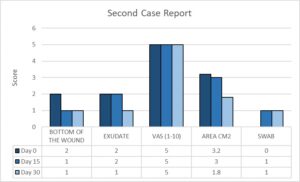
Figure 5: Second case report, parameters recorded at the baseline visit.

Figure 6: Second case report, A: bevor plasma treatment and B: after 30 days and 5 CAP treatments.
After 15 days with two cold plasma treatments the wound size was reduced to 1,8 cm2. The swabbing still resulted in bacterial load with Staph. aureus.
This wound improved in wound size reduction but not in other parameter like bacterial load or pain. Small wounds do not necessarily heal faster than large wounds. Even if the bacterial colonization was not completely reversed, CAP was able to reduce the size of the wound. Re-diagnosis with vascular status may be useful in a case like this before surgical coverage.
Third Case Report
Male patient (75 years old) with post-traumatic wound above the left ankle joint. Hypertension was documented as a comorbidity. The wound was conspicuous mainly due to its hyper granulation (Fig. 7,8). The parameter at base line were reported as (day 0).
Third Case Report
Male patient (75 years old) with post-traumatic wound above the left ankle joint. Hypertension was documented as a comorbidity. The wound was conspicuous mainly due to its hyper granulation (Fig. 7,8). The parameter at base line were reported as (day 0).
The result after 30 Days showed a significant reduction of the wound size to 5,0 square centimeter and the amount of exudate was decreased to non. The swab result showed no Staph. aureus or a fungal infection with candida, but a positive result for Streptococcus. One possible reason for this may be that the bacterial load is covered by the excess granulation tissue.

Figure 7: Third case report, parameters recorded at the baseline visit.
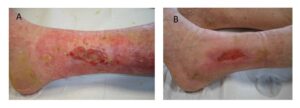
Figure 8: Third case report, A: bevor plasma treatment and B: after 30 days and 5 CAP treatments.
Venous disease is very common in Italy, in particular in people living in the South [18]. The overall recurrence rates for venous leg ulcers are given as 67-75%. 17% or 26-28% occur after 12 months, 37% after three years and 48% after five years with non-surgical treatment. On average, one third of patients suffer a recurrence, a further third two to three and the last third at least four recurrences third at least four recurrences. Wound bed preparation with cold plasma can make an important contribution to the preparation of surgical treatment and thus to the reduction of recurrences [19].
Discussion
The wounds included in this observational trial were chronic, complex wounds that showed no tendency to heal for more than 60 days under standard care. The treatment of these wounds repeatedly poses major challenges for healthcare providers. 41 wounds of 40 patients were treated with CAP in addition to guideline-compliant wound care. It should be noted that some wounds had an area of 50 cm² or more. The treatment duration of 13 cm² lasted 1 min each with the plasma care device. The maximum additional treatment time is therefore around 5 minutes per wound, significantly less for smaller wounds.
Most of these completely different wounds showed a significant reduction in the wound area, even if the bacterial load decreased differently under cold plasma therapy. An intervention period of 30 days and a maximum of 5 treatments is a very short time frame to bring complex wounds that have existed for at least 60 days to complete healing. During the treatment period, two patients left the trial. Of the remaining patients, 30% achieved a wound size reduction of at least 30 %, 10 of them even more than 40 %. The wound size was reduced on average from 22.6 cm² to 16.5 cm². In five patients, the wound did not improve or worsened during the course of treatment.
Most of these completely different wounds showed a significant reduction in the wound area, even if the bacterial load decreased differently under cold plasma therapy. An intervention period of 30 days and a maximum of 5 treatments is a very short time frame to bring complex wounds that have existed for at least 60 days to complete healing. During the treatment period, two patients left the trial. Of the remaining patients, 30% achieved a wound size reduction of at least 30 %, 10 of them even more than 40 %. The wound size was reduced on average from 22.6 cm² to 16.5 cm². In five patients, the wound did not improve or worsened during the course of treatment.
Obviously, it is necessary to recognize some limitations determined by the short treatment period, the clinical diversity of each wound and of the patients enrolled. However, the positivity rate of the results obtained in the Clinical Centers must be considered, which gives rise to hope for a further and more in-depth study.
Conclusion
As a new, interdisciplinary field of therapy and research, the use of cold plasma represents a promising approach to solving the problem of skin coverage in chronic wounds and promises to establish itself more and more as a therapeutic method with great potential in the future [22].
The plasma “cocktail” gas mixture seems to be the main reason for the synergistic antimicrobial and wound-healing effects of cold plasma [23]. In their observational study “Treatment of Wound Healing Disorders of Radial Forearm Free Flap Donor Sites Using Cold Atmospheric Plasma: A proof of concept”, Hartwig, et al., found an impressive positive effect of cold plasma on wound healing [24]. The present observational trial with 40 patients was able to confirm the positive effect of CAP on the wound bed. Wound conditioning is crucial in the treatment of chronic wounds. Appropriate antimicrobial management is essential both for conservative treatment and in preparation for surgery.
The rationale that the use of CAP can improve the healing rates of skin grafts is based on the assumption of minimizing the bacterial load and optimizing the wound environment. Thus, CAP can help to significantly improve healing rates, minimize the rate of postoperative wound healing disorders and reduce the number of reoperations.
New technologies in wound care do not have to be complex and can be integrated into existing care with little effort. The use of cold plasma, which is becoming increasingly established in wound care, does not have to be complex and time-consuming for patients and nursing staff. This observational trial confirms the positive findings to date regarding bacteria reduction and improved wound healing with good results also regarding the complete healing of complex wounds. Further RCT studies should therefore follow to create a solid database.
Conflict of Interests
The authors have no conflict of interest to declare.
Consent Declaration
This Declaration consists of two parts, namely the consent to the (clinical) trial itself and consent to the processing of personal data. Patient recruitment data sheets, clinical history of the lesion and results of swabs taken during the month of treatment, and adverse effects.
References
- Becker S, Zimmermann JL, Baumeister P, Brunner TF, Shimizu T, Li YF, et al. Effects of Cold Atmospheric Plasma (CAP) on bacteria and mucosa of the upper aerodigestive tract. Auris Nasus Larynx. 2019;46(2):294-301.
- Isbary G, Stolz W, Shimizu T, Monetti R, Bunk W, Schmidt HU, et al. Cold atmospheric argon plasma treatment may accelerate wound healing in chronic wounds: Results of an open retrospective randomized controlled study in-vivo. Clinical Plasma Med. 2013;1(2):25-30.
- Stratmann B, Costea TC, Nolte C, Hiller J, Schmidt J, Reindel J, et al. Effect of cold atmospheric plasma therapy vs standard therapy placebo on wound healing in patients with diabetic foot ulcers: a randomized clinical trial. JAMA Network Open. 2020;3(7):e2010411.
- Strohal R, Dietrich S, Mittlböck M, Hämmerle G. Chronic wounds treated with cold atmospheric plasmajet versus best practice wound dressings: A multicenter, randomized, non-inferiority trial. Scientific Reports. 2022;12(1):3645.
- Braný D, Dvorská D, Halašová E, Škovierová H. Cold atmospheric plasma: A powerful tool for modern medicine. Int J Mol Sci. 2020;21(8):2932.
- Hämmerle G, Ascher S, Gebhardt L. Positive effects of cold atmospheric plasma on pH in wounds: a pilot study. Journal of Wound Care. 2023;32(9):530-6.
- Schneider LA, Korber A, Grabbe S, Dissemond J. Influence of pH on wound-healing: a new perspective for wound-therapy? Arch Dermatol Res. 2007;298(9):413-20.
- Isbary G, Morfill G, Schmidt HU, Georgi M, Ramrath K, Heinlin J, et al. A first prospective randomized controlled trial to decrease bacterial load using cold atmospheric argon plasma on chronic wounds in patients. Br J Dermatol. 2010;163(1):78-82.
- Zimmermann JL, Dumler K, Shimizu T, Morfill GE, Wolf A, Boxhammer V, et al. Effects of cold atmospheric plasmas on adenoviruses in solution. J Physics D: Applied Physics. 2011;44(50):505201.
- Zimmermann JL, Shimizu T, Schmidt HU, Li YF, Morfill GE, Isbary G. Test for bacterial resistance build-up against plasma treatment. New J Physics. 2012;14(7):073037.
- Heinlin J, Maisch T, Zimmermann JL, Shimizu T, Holzmann T, Simon M, et al. Contact-free inactivation of Trichophyton rubrum and Microsporum canis by cold atmospheric plasma treatment. Future Microbiol. 2013;8(9):1097-106.
- Daeschlein G, Scholz S, Arnold A, Von Podewils S, Haase H, Emmert S, et al. In-vitro susceptibility of important skin and wound pathogens against low temperature Atmospheric Pressure Plasma Jet (APPJ) and Dielectric Barrier Discharge plasma (DBD). Plasma Processes and Polymers. 2012;9(4):380-9.
- Daeschlein G, Napp M, Lutze S, Arnold A, von Podewils S, Guembel D, et al. Skin and wound decontamination of multidrug‐resistant bacteria by cold atmospheric plasma coagulation. JDDG. 2015;13(2):143-9.
- Daeschlein G, Napp M, Von Podewils S, Lutze S, Emmert S, Lange A, et al. In-vitro susceptibility of multidrug resistant skin and wound pathogens against low temperature Atmospheric Pressure Plasma Jet (APPJ) and Dielectric Barrier Discharge plasma (DBD). Plasma Processes and Polymers. 2014;11(2):175-83.
- Napp M, Von Podewils S, Klare I, Haase H, Kasch R, Gümbel D, et al. Does antibiotic resistance impair plasma susceptibility of multi-drug resistant clinical isolates of enterococci in-vitro? Gut Pathogens. 2016;8:1-7.
- Ghaderi F, Banakar S, Rostami S. Effect of pre-cooling injection site on pain perception in pediatric dentistry: A randomized clinical trial. Dent Res J. 2013;10(6):790.
- Schryvers OI, Stranc MF, Nance PW. Surgical treatment of pressure ulcers: 20-year experience. Arch Phys Med Rehabil. 2000;81(12):1556-62.
- Chiesa R, Marone EM, Limoni C, Volonté M, Schaefer E, Petrini O. Chronic venous insufficiency in Italy: the 24-cities cohort study. Euro J Vascular and Endovascular Surg. 2005;30(4):422-9.
- Gohel MS, Taylor M, Earnshaw JJ, Heather BP, Poskitt KR, Whyman MR. Risk factors for delayed healing and recurrence of chronic venous leg ulcers-an analysis of 1324 legs. Euro J Vascular and Endovascular Surg. 2005;29(1):74-7.
- Metelmann HR, von Woedtke T, Weltmann KD, Emmert S, editors. Textbook of good clinical practice in cold plasma therapy. Berlin, Germany: Springer; 2022.
- Serena TE, Yaakov R, DiMarco D, Le L, Taffe E, Donaldson M, et al. Dehydrated human amnion/chorion membrane treatment of venous leg ulcers: correlation between 4-week and 24-week outcomes. J Wound Care. 2015;24(11):530-4.
- Sziegoleit M. Cold plasma therapy in postoperative wound care (Doctoral dissertation, lmu). 2022.
- Plasma medicine: Cold plasma in medical applications. Springer, Berlin Heidelberg. 2016.
- Hartwig S, Doll C, Voss JO, Hertel M, Preissner S, Raguse JD. Treatment of wound healing disorders of radial forearm free flap donor sites using cold atmospheric plasma: a proof of concept. J Oral and Maxill Surg. 2017;75(2):429-35.
Article Type
Research Article
Publication History
Received On: 26-03-2024
Accepted On: 23-04-2024
Published On: 30-04-2024
Copyright© 2024 by Ligresti C, et al. All rights reserved. This is an open access article distributed under the terms of the Creative Commons Attribution License, which permits unrestricted use, distribution, and reproduction in any medium, provided the original author and source are credited.
Citation: Ligresti C, et al. Use of Cold Plasma in the Treatment of Infected Wounds. J Surg Res Prac. 2024;5(1):1-10.

Figure 1: Measurement of wound size.

Figure 2: VAS Score, figure from Ghaderi, et al., [16].

Figure 3: First case report, parameters recorded at the baseline visit.

Figure 4: First case report, A) after 15 days and B) after 30 days and 5 CAP treatments.

Figure 5: Second case report, parameters recorded at the baseline visit.

Figure 6: Second case report, A: bevor plasma treatment and B: after 30 days and 5 CAP treatments.

Figure 7: Third case report, parameters recorded at the baseline visit.

Figure 8: Third case report, A: bevor plasma treatment and B: after 30 days and 5 CAP treatments.
Wound Size in cm² | Wound Size reduction in % | Pain (VAS score) | ||||||||
All Wounds | Wounds > 18 cm² | All Wounds | Wounds > 18 cm² | All Wounds | Wounds > 18 cm² | |||||
Day | Average | SD | Average | SD | Average | Average | Average | SD | Average | SD |
0 | 22,7 | 14,7 | 34,3 | 10,6 | 0% | 0% | 5,6 | 2,6 | 5,5 | 2,5 |
15 | 20,7 | 13,6 | 30,2 | 10,8 | 10% | 12% | 5,2 | 2,4 | 4,9 | 1,9 |
30 | 16,5 | 11,1 | 23,7 | 9,4 | 28% | 31% | 4,6 | 2,2 | 4,4 | 1,9 |
Table 1: Wound size, Reduction of wound size compared to day 0 and development of pain within 30 days of plasma treatment.
Wound Bed | Exudate | Pain | Area | Swab | |
Deterioration | 10% | 5% | 13% | 8% | 15% |
Constant | 25% | 35% | 38% | 5% | 30% |
Improvement | 65% | 60% | 50% | 85% | 55% |
Table 2: Overview over success of treatment.


